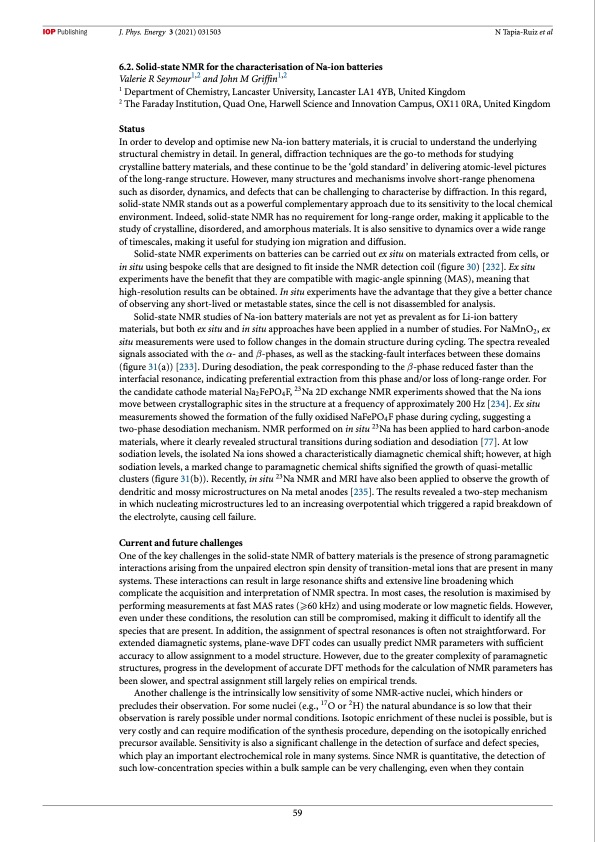
PDF Publication Title:
Text from PDF Page: 060
J. Phys. Energy 3 (2021) 031503 N Tapia-Ruiz et al 6.2. Solid-state NMR for the characterisation of Na-ion batteries Valerie R Seymour1,2 and John M Griffin1,2 1 Department of Chemistry, Lancaster University, Lancaster LA1 4YB, United Kingdom 2 The Faraday Institution, Quad One, Harwell Science and Innovation Campus, OX11 0RA, United Kingdom Status In order to develop and optimise new Na-ion battery materials, it is crucial to understand the underlying structural chemistry in detail. In general, diffraction techniques are the go-to methods for studying crystalline battery materials, and these continue to be the ‘gold standard’ in delivering atomic-level pictures of the long-range structure. However, many structures and mechanisms involve short-range phenomena such as disorder, dynamics, and defects that can be challenging to characterise by diffraction. In this regard, solid-state NMR stands out as a powerful complementary approach due to its sensitivity to the local chemical environment. Indeed, solid-state NMR has no requirement for long-range order, making it applicable to the study of crystalline, disordered, and amorphous materials. It is also sensitive to dynamics over a wide range of timescales, making it useful for studying ion migration and diffusion. Solid-state NMR experiments on batteries can be carried out ex situ on materials extracted from cells, or in situ using bespoke cells that are designed to fit inside the NMR detection coil (figure 30) [232]. Ex situ experiments have the benefit that they are compatible with magic-angle spinning (MAS), meaning that high-resolution results can be obtained. In situ experiments have the advantage that they give a better chance of observing any short-lived or metastable states, since the cell is not disassembled for analysis. Solid-state NMR studies of Na-ion battery materials are not yet as prevalent as for Li-ion battery materials, but both ex situ and in situ approaches have been applied in a number of studies. For NaMnO2, ex situ measurements were used to follow changes in the domain structure during cycling. The spectra revealed signals associated with the α- and β-phases, as well as the stacking-fault interfaces between these domains (figure 31(a)) [233]. During desodiation, the peak corresponding to the β-phase reduced faster than the interfacial resonance, indicating preferential extraction from this phase and/or loss of long-range order. For the candidate cathode material Na2FePO4F, 23Na 2D exchange NMR experiments showed that the Na ions move between crystallographic sites in the structure at a frequency of approximately 200 Hz [234]. Ex situ measurements showed the formation of the fully oxidised NaFePO4F phase during cycling, suggesting a two-phase desodiation mechanism. NMR performed on in situ 23Na has been applied to hard carbon-anode materials, where it clearly revealed structural transitions during sodiation and desodiation [77]. At low sodiation levels, the isolated Na ions showed a characteristically diamagnetic chemical shift; however, at high sodiation levels, a marked change to paramagnetic chemical shifts signified the growth of quasi-metallic clusters (figure 31(b)). Recently, in situ 23Na NMR and MRI have also been applied to observe the growth of dendritic and mossy microstructures on Na metal anodes [235]. The results revealed a two-step mechanism in which nucleating microstructures led to an increasing overpotential which triggered a rapid breakdown of the electrolyte, causing cell failure. Current and future challenges One of the key challenges in the solid-state NMR of battery materials is the presence of strong paramagnetic interactions arising from the unpaired electron spin density of transition-metal ions that are present in many systems. These interactions can result in large resonance shifts and extensive line broadening which complicate the acquisition and interpretation of NMR spectra. In most cases, the resolution is maximised by performing measurements at fast MAS rates (⩾60 kHz) and using moderate or low magnetic fields. However, even under these conditions, the resolution can still be compromised, making it difficult to identify all the species that are present. In addition, the assignment of spectral resonances is often not straightforward. For extended diamagnetic systems, plane-wave DFT codes can usually predict NMR parameters with sufficient accuracy to allow assignment to a model structure. However, due to the greater complexity of paramagnetic structures, progress in the development of accurate DFT methods for the calculation of NMR parameters has been slower, and spectral assignment still largely relies on empirical trends. Another challenge is the intrinsically low sensitivity of some NMR-active nuclei, which hinders or precludes their observation. For some nuclei (e.g., 17O or 2H) the natural abundance is so low that their observation is rarely possible under normal conditions. Isotopic enrichment of these nuclei is possible, but is very costly and can require modification of the synthesis procedure, depending on the isotopically enriched precursor available. Sensitivity is also a significant challenge in the detection of surface and defect species, which play an important electrochemical role in many systems. Since NMR is quantitative, the detection of such low-concentration species within a bulk sample can be very challenging, even when they contain 59PDF Image | 2021 roadmap for sodium-ion batteries

PDF Search Title:
2021 roadmap for sodium-ion batteriesOriginal File Name Searched:
roadmap-sodium-ion-batteries_031503.pdfDIY PDF Search: Google It | Yahoo | Bing
Salgenx Redox Flow Battery Technology: Salt water flow battery technology with low cost and great energy density that can be used for power storage and thermal storage. Let us de-risk your production using our license. Our aqueous flow battery is less cost than Tesla Megapack and available faster. Redox flow battery. No membrane needed like with Vanadium, or Bromine. Salgenx flow battery
| CONTACT TEL: 608-238-6001 Email: greg@salgenx.com | RSS | AMP |